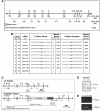The ETS transcription factor GABPalpha is essential for early embryogenesis
- PMID: 15199140
- PMCID: PMC480913
- DOI: 10.1128/MCB.24.13.5844-5849.2004
The ETS transcription factor GABPalpha is essential for early embryogenesis
Abstract
The ETS transcription factor complex GABP consists of the GABPalpha protein, containing an ETS DNA binding domain, and an unrelated GABPbeta protein, containing a transactivation domain and nuclear localization signal. GABP has been shown in vitro to regulate the expression of nuclear genes involved in mitochondrial respiration and neuromuscular signaling. We investigated the in vivo function of GABP by generating a null mutation in the murine Gabpalpha gene. Embryos homozygous for the null Gabpalpha allele die prior to implantation, consistent with the broad expression of Gabpalpha throughout embryogenesis and in embryonic stem cells. Gabpalpha(+/-) mice demonstrated no detectable phenotype and unaltered protein levels in the panel of tissues examined. This indicates that Gabpalpha protein levels are tightly regulated to protect cells from the effects of loss of Gabp complex function. These results show that Gabpalpha function is essential and is not compensated for by other ETS transcription factors in the mouse, and they are consistent with a specific requirement for Gabp expression for the maintenance of target genes involved in essential mitochondrial cellular functions during early cleavage events of the embryo.
Figures



References
-
- Bister, K., M. Nunn, C. Moscovici, B. Perbal, M. A. Baluda, and P. H. Duesberg. 1982. Acute leukemia viruses E26 and avian myeloblastosis virus have related transformation-specific RNA sequences but different genetic structures, gene products, and oncogenic properties. Proc. Natl. Acad. Sci. USA 79:3677-3681. - PMC - PubMed
MeSH terms
Substances
LinkOut - more resources
Full Text Sources
Molecular Biology Databases
